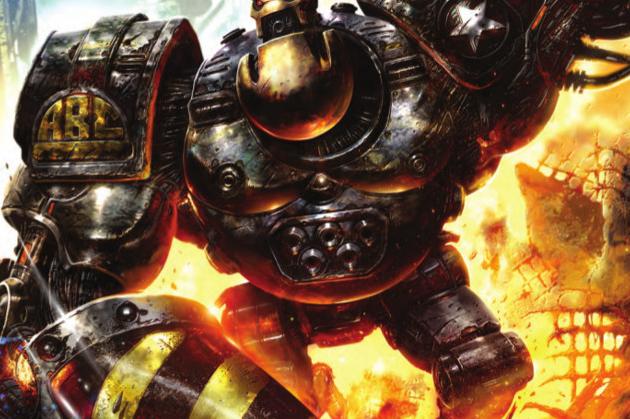2000AD, PROG 2062
Writers: Michael Carroll; Pat Mils; Ian Edginton; Peter Milligan
Artists: Colin MacNeil; Patrick Goddard; INJ Culbard; Clint Langley; Rufus Dayglo
Colourists: Chris Blythe; Dominic Regan
Letterers: Annie Parkhouse; Elle De Ville; Simon Bowland
Publisher: Rebellion
Having crash landed in the snowy Russian wastes, Dredd has found himself amid the ruins of East Meg One, the city he destroyed with a nuclear strike way back in 1982 at the climax of the epic Apocalypse War storyline. The ghosts of the dead are restless and out for revenge.
The second episode of Judge Dredd: Echoes is perhaps a little functional, but necessary for the narrative, explaining the backstory for anyone unfamiliar with nearly forty years Dredd history, whilst building the tension as various members of the band of scavengers and survivors succumb to dark forces. The slow building story does give Dredd the opportunity to express his own views on his murdering half a billion people half a life time ago, and unsurprisingly the big man’s views are again functional. Although, deftly written small and subtle cues in Michael Carroll’s dialogue suggest a deeper truth left unspoken beneath that stoney surface.
Have you ever had a song stuck in your head and it won't go away? When no matter what you do, it’s still there, playing on a loop?
Serial killing freedom fighter Bill Savage is shooting Transformers on a train in Savage: The Thousand Year Stare, but still we get the same lyrics from the American folk song “Stagolee” cutting through the narrative, like an unnecessary stylistic affectation that lost it's purpose long ago. There’s some nice explosive action, but again is all a little functional, as Bill’s increasingly bizarre actions are driven by his need to move the plot forward rather than behave as a reasonable human might – seeing clues in graffiti, accepting unnecessary help from someone he constantly expects to betray him, and here being completely unsurprised by the sudden appearance of a spaceship, which he tries to escape by jumping onboard. Try as he might, that earworm won't leave Bill alone.
And still the question that was first asked more than a year ago remains unanswered. What is "The Thousand Year Stare", and for how long can we pretend that we don’t know it’s a secret Volgan timemachine?
Clint Langley’s art on ABC Warriors: Fallout is truly unique. With his often static looking humans taking a backseat to massive robots and alien cityscapes, each panel is full of shiny, chrome-plated storytelling. Here, big dumb robot Mongrol gets angry on some high flying public transport and some smashing ensues. Unfortunately, the monotonous evil of the Bad Guys intrudes and forces a plot upon us, filled with an unoriginal satirising of of social media (at this stage, is there anyone left who thinks that Facebook isn’t an evil organisation?), and a mishmash of weird puns on British Rail slogans from the 70s, and Walt Whitman poems.
As with the ABC Warriors, Bad Company are a band of misfit soldiers, waging an endless war. The original Bad Company appeared in a self contained story back in the mid '80s, with the theme of how war is hell and can make men into monsters. Boldly taking these tropes and running with them, Bad Company blended a cacophony of weird and wonderful men made into monsters, seeking revenge on the alien world they had become part of.
Resurrecting the company members to deal with a post-war world, Bad Company: Terrorists features neon art from Rufus Dayglo and Dominic Regan, heavily inspired by original art from Brett Ewins and Brendan McCarthy. Terrorists is certainly eye catching but says little new, with the band on the run and wandering through the wreckage of a collapsed society on a mission of revenge. In a real world of fake news and Brexit, wonderful characters like the haunted diarist Danny Franks or fiercely deluded Mad Tommy Churchill could be reinvented for modern readers, but they are little more than cameos.
Brass Sun is a colossal adventure, with a vast universe and scope. The scale of the universe is gradually reintroduced in the second part of Brass Sun: Engine Summer. After last week’s prog nonchalantly throwing in a word balloon with the line “two thousand years later”, here the focus is on two conversations, as characters restate their intentions. It’s a quiet episode without action, but the majesty of Brass Sun is clear from its band of strange characters and their epic quests, slowling piecing together the cogs of this clockwork punk masterpiece.





